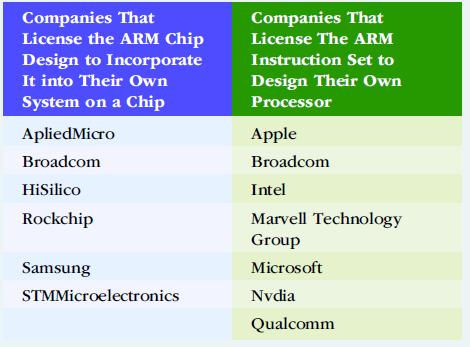1. What are some of the challenges and opportunities facing the processor chip industry in general and...
Question:
1. What are some of the challenges and opportunities facing the processor chip industry in general and ARM in particular?
2. Some chip industry observers and financial analysts believe that because of its licensing business model, ARM missed an opportunity to capture billions of dollars in sales of microprocessor chips it could have manufacturered. Compare sales, profits, and stock prices over a three-year period for ARM to two of its customers who do have fab plants and manufacture their own chips such as Samsung Electronics and Intel or AMD, a competitor. Do you believe that the ARM licensing rather than manufacturing business model has hurt the firm? Why or why not?
3. Do research to learn more about how China came to be the lead assembler of the world’s smartphones and computers. What are some of the pros and cons of outsoucring this work to China?
ARM
The Acorn Computer Group developed the world’s first commercial Reduced Instruction Set Computer (RISC) processor in the 1980s. The simpler commands employed in RISC computers enables the computer to operate faster, use less power, and take up less space—major advances over the early complex instruction set computer systems (CISC), which tried to pack as many actions into each command as possible.ARM was founded in 1990 as a spin-off of Acorn Computer and Apple after the two companies began collaborating on the ARM processor for the Newton computer system—Apple’s ill-fated attempt at a handheld computer. The ARM business model involves the design and license of intellectual property rather than the manufacture and sales of actual semiconductor chips. ARM licenses the rights to build chips based on its design to the world’s leading semiconductor and systems companies. These companies pay ARM a license fee for the original design along with a royalty
on every chip or wafer produced. ARM has signed over 1,100.
licenses with more than 300 companies. Some companies elect to license the ARM instruction set to design their own processors. See Table 3.9.

Over 60 billion ARM chips have been shipped since the company was founded. Chips based on ARM designs are found in 99 percent of the world’s smartphones and tablets. In addition, processors based on designs licensed from ARM are used in all sorts of computing devices, including microcontrollers in embedded systems such as antilock braking systems (ABS) systems for autos, smartTVs, and smartwatches. The number of ARM-designed chips sold is estimated to be 25 times that of Intel-designed chips. Personal computer vendors upgrade their products
every 12 to 18 months. The smartphone industry is demanding an upgrade every six months to a year. ARM is constantly striving to keep pace with these demands.
The Cortex-A57 is a processor design by ARM that was announced in October 2012 and appeared in handsets two years later. The Cortex-A72, its successor, was announced in February 2015 and began to appear in mobile devices by the end of 2015.The Cortex A72 processor represents a 50 times increase in processing power compared with smartphone chips used just five years ago. Development of
the Cortex A-72 continues the trend of smartphones getting more and more powerful and becoming our primary computing device, replacing the personal computer for many uses............
Step by Step Answer:

Principles of Information Systems
ISBN: 978-1305971776
13th edition
Authors: Ralph Stair, George Reynolds





